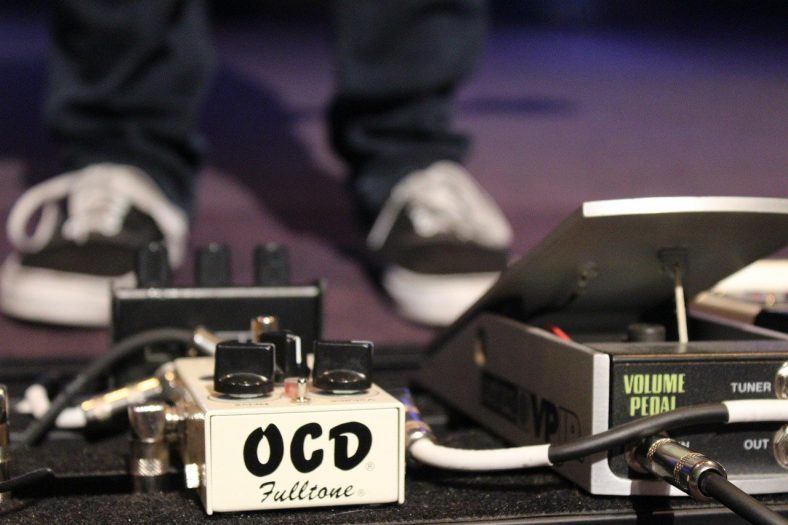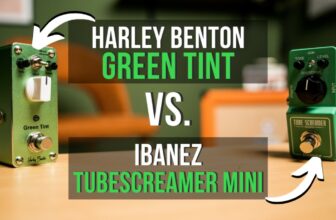How to Setup A Guitar Pedalboard (Best Pedals, Most Important Effects)

If you want to get a great tone, you need more than just guitar and amp, you need a well-organized pedalboard. We will take the guesswork out of setting up a great pedalboard!
Guitar pedalboards can end up being quite expensive if you don’t plan them carefully. We are here to make some suggestions, to help you find your tone easier, and also save some money.
A simpler alternative to building a pedalboard is getting a multi-effects pedal.
Contents
- How to Build a Pedalboard
- Best Types of Guitar Pedals for Your Pedalboard
- Ibanez TS808 Overdrive Pedal
- JHS Bonsai 9-Way Screamer Overdrive
- BOSS Distortion Guitar Pedal (DS-1)
- Electro Harmonix Oceans 11 Reverb Pedal
- Boss DD-7 Digital Delay Pedal
- MXR M102 Dyna Comp Compresor Pedal
- Fender Bubbler Chorus Pedal
- TC Electronic PolyTune 3
- Pedalboard Power Supply
- How To Organize Your Pedalboard
- Summary
How to Build a Pedalboard
1. Choose a good variety of guitar pedals – Our list below includes some of the essentials
2. Get a pedalboard power supply
3. Organize your pedalboard – Sequence them in the right order and connect them together with good guitar patch cables
4. Get a board with enough space – though don’t get one that’s too big and awkward to carry around!
When you are making a pedalboard, the best thing you can do is to start with the essential guitar effects. Once you get all of them, you can say you have a good base for further build-ups.
So, here are the most important guitar effects you need to have on your pedalboard.
Best Types of Guitar Pedals for Your Pedalboard
1. Overdrive and Distortion
For most of us, the first thing that comes to mind is a good overdrive/distortion pedal. Whether your amp has a built-in gain channel or not, you will hardly get the tone you want without this pedal, as the most iconic overdrive tones have been shaped through pedals.
When it comes to overdrive pedals, the first one that comes to mind is, without any doubt, Ibanez Tube Screamer (TS-808).
This is one of the most iconic overdrive pedals of all time both in terms of the tone and popularity. It shaped the overdrive tone and there aren’t many players that don’t use this pedal or some of its clones.
Speaking of the clones, there are so many pedals on the market that offer the same or similar design, so you can easily find cheaper alternatives, or get something that offers genuine tone but adds functionality, like the JHS Bonsai 9-Way Screamer Overdrive.
If your playing style requires something more aggressive, a good distortion pedal is what you need. The choice is huge these days but our advice would be stick to proven solutions until you find your own preferences.
The Boss DS-1 would be a natural choice (Check out our Boss DS-1 review to learn more). This pedal is affordable but offers a lot of things in return. It sounds great, it’s easy to use and it is something that has been an essential part of so many pedalboards for decades.
2. Reverb
Reverb is another quintessential guitar effect you must have on your pedalboard.
A good thing to know is that many guitar amps come with built-in reverb. That has been a practice since the early days of guitar amps.
However, many of these reverb effects don’t sound so great, unless you have a vintage Fender or some boutique amp that costs thousands of dollars. Therefore, a good pedal would be a rational choice.
Our recommendation would be the Electro-Harmonix Oceans 11, which offers great versatility, great tone quality and remains reasonably priced and easy to use at the same time.
3. Delay
It’s hard to imagine any good guitar tone without a delay pedal. Whether it’s about massive lead tones one adding a new dimension to your chords and rhythm sound, you need a good delay pedal.
These days, delay pedals are far more than just a unit that replicates the original signal for a certain time, at a certain speed. These units are so versatile these days that you can drastically change your tone and get tons of different colors.
The offer of delay pedals is huge and differences between all these units are pretty big as well. However, most of them stick to certain standards, so it’s always good to start with some classic and proven design.
The Boss DD-7 is one of the most popular choices, popular both among professionals and amateurs.
The sound quality is very good, while the amount of options is great. At the same time, the pedal is intuitive and easy to use, while finding great tones is super easy.
You can either go for digital delay pedals or analog delay pedals.
4. Compressor
No matter how technically skilled player you are, you need something that will tighten your tone. That’s why most guitar players use a compressor pedal.
This effect takes care of so-called dynamic range compression, which means it amplifies quiet notes and reduces those that are too loud. In practice, this means more muscles in your tone, so besides compression function, these units are also used as boost pedals.
As we are talking about one of the most important effects for electric guitars, the offer is huge. One of the most popular choices is MXR Dyna Comp. Players appreciate its tonal characteristics, easiness of use and super compact dimensions.
5. Chorus
Modulation effects are also hugely important and among them, the first one that comes to mind is a chorus. This effect is vastly important for your clean tones, especially when it comes to chord voicing.
A chorus pedal takes the original signal and copies it multiple times. These copies are delayed and pitch modulated in a low-frequency oscillation. That provides a signature sound, which can be heard in so many songs in popular music.
The offer of these pedals on the market is huge and one of the most popular choices is a pedal that comes from Fender, called Bubbler Chorus.
This pedal offers an impressive range of tones and a full load of tweaking options, so you can easily change speed, waveforms and all other parameters.
Besides chorus, other popular modulation effects are flanger, phaser etc.
6. Tuner
All these pedal effects are hugely important for a good guitar tone, but none of them will help if you are not in tune. Therefore, a good tuner pedal is also an essential part of every pedalboard.
Even if you have an absolute pitch, it won’t help you on stage, where there is a lot of noise. So, getting one of these pedals is critical, as it allows you to get back in tune really fast. The number of tuner pedals is pretty big these days and one of the products that currently stand out is TC Electronic PolyTune3.
This tuner is super compact and offers a polyphonic mode that allows you to check all strings at once. Also, it features a super-precise strobe mode, which makes it one of the most accurate tuners around. Finally, it comes with a built-in BonaFide buffer.
Pedalboard Power Supply
Pedalboard power supplies are power transformers that use one power input and then split for use with multiple pedals. Otherwise it can be an issue trying to power all those pedals! You certainly don’t want to be using batteries!
Check out our article on the best pedalboard power supplies for more information.
How To Organize Your Pedalboard
Pedal Order
There are some common rules when it comes to the pedal chain. These help to give the best results not just in terms of the sound of each effect, but also in terms of tone preserving when some of the units are not engaged.
- The signal chain usually starts with a tuner and compression pedal.
- It then continues with overdrive and distortion pedals. These effects go before your preamp pedal.
- Modulation effects are the first ones that go after the preamp.
- Delay and reverb pedals come last
This would be a typical chain for the pedals we consider most essential. Once you get all these units, you will probably start to think about further additions.
We already mentioned other effects, while the list of popular pedals also includes wah, volume pedal, equalizer, looper pedal, treble booster, octave fuzz, envelope filter etc.
On the other side, the equalizer usually goes right after the preamp, before modulation, delay and reverb. When it comes to a volume pedal, most players like to put it right after a tuner, but it’s not a rare thing to see it after a preamp either.
Guitar Patch Cables
Next you need some good quality guitar patch cables to connect them all together. The quality of these can affect the sound so be sure to get the best ones for your budget.
Summary
Keep in mind that these are just our suggestions, based on some common practice. The fact is that there are no strict rules in terms of signal chain configuration, so you can try all kinds of different orders to find the tone you want to build the best pedalboard to suit your sound.













